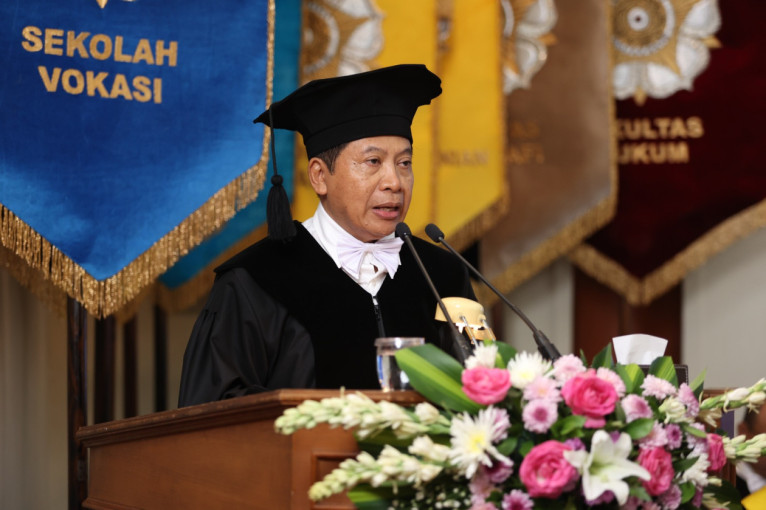
Dr. Agus Maryono, the Dean of the UGM Vocational College, was recently appointed as a professor in water resources and environment at UGM.
His inaugural speech, “Developing Science and Technology in Harvesting Rainwater: from Concerns, Research, and Technological Development towards Community Movements and Teaching Factories,” sheds light on his groundbreaking work in water resources and the environment.
Addressing the prevailing challenges in water resource and environmental management, Professor Agus Maryono critiqued the existing pragmatic and exploitative paradigms.
He highlighted the adverse impact of conventional river and lake development methods, emphasizing the need for environmentally friendly approaches. Some examples include river straightening, embankment, riverbank concreting, and the massive construction of check dams, ground sills, and sabo dams.
“The development of lakes and reservoirs still uses conventional construction methods such as constructing embankments and concreting lake banks, which damage the lake ecosystem,” he underscored during his speech at the UGM Senate Hall on Tuesday (Jan. 30).
Various issues are also found in rainwater management, where the construction of rainwater drainage in rural areas, settlements, cities, and areas is still done with the concept of quickly draining rainwater into rivers, which can lead to downstream flooding and upstream droughts.
Therefore, reforming environmentally friendly and sustainable water resource management is urgently needed.
“The extent of the water resources and environmental problems prompted me to choose one of the urgent and current themes during the peak of the rainy season and climate change today, namely rainwater management. More specifically, I will discuss the development of science and technology (S&T) in harvesting rainwater,” he explained.
He chose the main topic of rainwater management because it can provide a comprehensive reflection on how science and technology should be developed and socialized to address real societal problems. Therefore, in his speech, he recounted the process of developing rainwater harvesting S&T and its implementation to meet the clean water needs of the wider community.
“This theme aligns with our efforts to reform rainwater management and support the Sustainable Development Goals (SDGs) by 2030,” he elaborated.
The birth of the Gama Rain Filter
Speaking about the development of rainwater harvesting technology and seeing the very large quantity of rainwater with quality that meets clean water standards and the increasing water needs of the community, Professor Agus Maryono’s journey in rainwater harvesting technology began over a decade ago at the Water and Environmental Building Laboratory, Vocational College, UGM.
Through meticulous phases spanning 2010 to 2025, he and his team developed the Gama Rain Filter—an innovative rainwater collection and filtration device. The first phase began in 2010-2015, focusing on developing rainwater harvesting technology. The second phase in 2016-2020 focused on technology development and intellectual property registration, and the third phase in 2021-2025 focused on technology development and building a Teaching Factory (TeFa).
Professor Maryono said that rainwater harvesting technology has already been developed traditionally and modernly in many countries such as Bangladesh, Australia, and Germany, as well as traditional rainwater harvesting technology used in various regions in Indonesia.
Traditional technology generally collects rain directly without filtering and is not yet associated with groundwater injection.
“I compiled and developed as many as 12 rainwater harvesting methods with example problems and dimension calculations. These include rainwater reservoirs, infiltration wells, infiltration trenches, infiltration areas, yard embankments, yard fences, excavation holes, landscape modifications, groundwater conservation areas, reservoirs, pond revitalization, and plants and forests as rainwater harvesters,” he said.
From these 12 technologies, he then decided to develop the Gama Rain Filter rainwater collection and filtration technology. This device improves traditional rainwater reservoir technology from house roofs with additional leaf, coarse dust, and fine dust filters.
This device has a portable reservoir, can automatically drain excess water to a well or infiltration well, and distribute rainwater for clean water needs. This technology can utilize almost 100 percent of rainwater from the house roof.
“Gama Rain Filter has received the UGM’s Best Patentable Award in 2016 and the UGM’s Best Patent in 2020. Its constituent materials are 100 percent available in the market and can be made by ten people with adequate training. These two awards were achieved because the community accepted this technology with such rapid spread,” he explained.
To ensure whether the community can accept this technology, he and his team conducted user acceptance research with 58 respondents from Gama Rain Filter users who have used the tool for 1 (one) year in Yogyakarta.
The results show that 76.3 percent of users understand the tool’s usefulness after installation, 81.3 percent rate the quality of the collected rainwater as good enough, 91.5 percent state that they are currently satisfied using rainwater, and 94.9 percent state that this tool is very beneficial.
“These results underscore the community’s acceptance of rainwater harvesting. We are committed to further developing and promoting this technology on a larger scale,” Professor Maryono affirmed.
With this lecture, he hopes to make an ontological and epistemological contribution in promoting real axiological impacts in practical terms toward environmentally friendly and sustainable rainwater resource management.
Through his pioneering efforts in rainwater harvesting, he seeks to raise public and government awareness that rainwater is suitable for management, harvesting, and utilization as a source of clean water that will save the Indonesian nation from future water crises.
Author: Agung Nugroho
Photographer: Firsto

